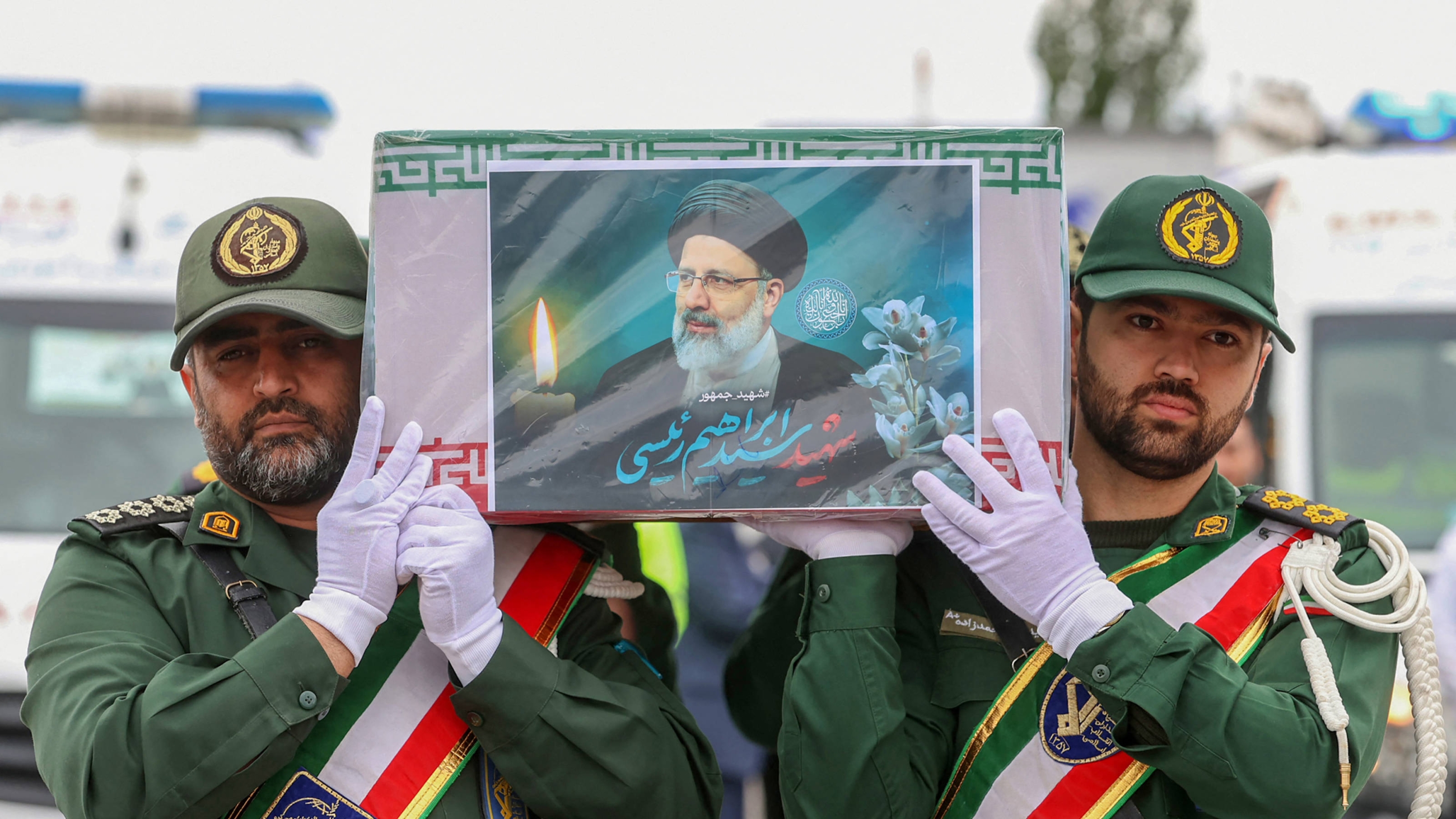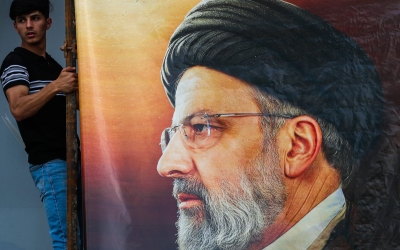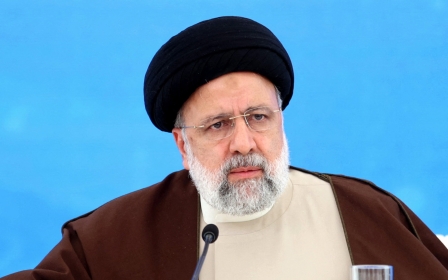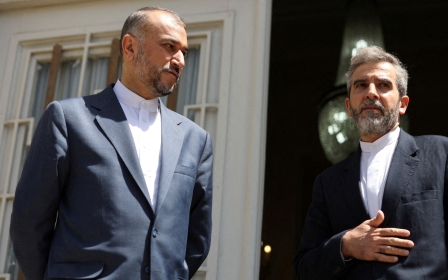Ebrahim Raisi's death: Doubts in Iran persist over official narrative of helicopter crash

Gholam-Hossein Esmaili stepped on to the helicopter soon after 1pm on 19 May. The chief of staff of Iranian President Ebrahim Raisi had boarded the aircraft at the front of the convoy. Behind him, his boss, the foreign minister and other officials stepped into the second.
About half an hour into the journey across East Azerbaijan province, a cloud was spotted in a valley near the Sungun copper mine. Esmaili recalls that the three-chopper convoy was travelling at an altitude slightly below cloud level.
According to Esmaili, the pilot of the president’s helicopter, as the field commander, instructed the others to fly above the clouds. Raisi’s helicopter was in the middle.
“After 30 seconds of continuing the path above the clouds, our pilot realised that the middle helicopter was missing,” Esmaili said in an interview with state TV.
The last communication with Raisi’s pilot had been a minute and a half earlier.
New MEE newsletter: Jerusalem Dispatch
Sign up to get the latest insights and analysis on Israel-Palestine, alongside Turkey Unpacked and other MEE newsletters
The president's helicopter, it appeared, had not gone above the cloud, according to Ali Bahadori Jahromi, a government spokesperson.
Esmaili's helicopter circled the area for 10 minutes but found no trace of the missing aircraft. Around 1.50pm, it landed at the nearest point, in the area of the Sungun Copper Factory.
Esmaili said they called the president's pilot, but it was Mohammad Ali Aale-Hashem, a senior cleric, who answered the phone.
“I don’t know where I am, I can’t see anyone. I am not well,” Aale-Hashem said, as quoted by Esmaili. Aale-Hashem managed to answer calls for around three to four hours.
Official narrative
After 14 hours of searching, hindered by extreme weather, rescue teams finally reached the site where the helicopter had crashed, killing all passengers, at around 5am local time.
The aircraft had fragmented and caught fire upon crashing into the mountain, a senior rescue member told local media.
Two bodies were found severely burned, one partially burned, and one significantly fractured. A short distance away, the body of the Tabriz cleric was found on muddy ground. He had died of internal bleeding.
“When the bodies were found, it was evident that the president and his companions had died instantly, but Aale-Hashem died a few hours later,” Esmaili said.
The flight crew members had suffered the brunt of the impact, according to the rescuer.
A source inside Raisi's government told Middle East Eye, on condition of anonymity, that no evidence of foul play has so far been found, and adverse weather and poor visibility due to thick fog appear to be the main causes of the incident.
The source said potential causes could also include pilot error or technical malfunction.
Jahromi, the government spokesperson, said the reasons why the helicopter flew through the cloud and the fog instead of above it must be investigated.
'Highly strange'
Although there has been no declared evidence of foul play, the official line has not stopped commentators and officials from questioning the narrative.
A former military commander highlighted the absence of a military helicopter as part of the presidential convoy that day.
“This is highly strange to me, as there is a protocol about the flights carrying presidents in Iran,” the former commander told MEE on condition of anonymity.
'I think it is highly likely that this is a planned accident by either foreign or local enemies'
- Iranian conservative
According to this protocol, he said, two Cobra attack helicopters must escort the president's aircraft, but in this case, there has been no indication that a Cobra was part of the entourage.
A former official in the establishment also cast doubt on the official line, telling MEE: “I highly doubt the official narrative. I even believe that the rescue mission could have reached good results in one hour, not a full day.
“It is not only me, but many haven't bought the official narrative,” the former official said.
Meanwhile, a source in the conservative camp said: "I don't have any information, but I think it is highly likely that this is a planned accident by either foreign or local enemies.
“Two decades ago, a group of senior moderate Revolutionary Guard commanders died in a plane crash, and at the time we heard that this wasn't just an accident,” he told MEE.
Conspiracy theories
Last week, the head of the Iranian army, Major General Mohammad Bagheri, released a preliminary investigation report that said, “no traces of bullets or similar items were found” in the wreckage of the helicopter.
It also said nothing suspicious was detected in the exchange between the helicopter's flight crew and the watchtower.
The report called on the Iranian public to pay no attention to “unverified and speculative comments”, especially ones pushed by foreign media.
But local media has also addressed the pervading doubts regarding the official narrative.
In a piece published on 23 May, Jomhouri Eslami, a Tehran-based moderate to conservative newspaper, noted that although it was initially believed that weather conditions had caused the helicopter crash, “now all minds are focused on the strong speculations about the 'incident being part of a conspiracy'”.
Pointing to the accident's location, near the Iran-Azerbaijan border, the Jomhouri Eslami emphasised that “the presence of Israeli military, intelligence, and communications facilities along the Azerbaijani border raises the possibility of Israel's involvement in Raisi's helicopter crash”.
Citing comments from technical experts who had said “the helicopter first exploded in the air and then crashed”, the paper argued: “In this case, the incident could result from external or internal interference with the helicopter.”
The newspaper presented a third scenario where the helicopter could have been sabotaged through the “disruption and malfunction of its radar and navigation equipment”.
Sanctions' impact on aircraft quality
Speaking to MEE, an aviation industry expert said presidential helicopters are overseen by the military and therefore adhere to different checks and standards than the regulations that civilian aircraft need to meet to obtain permits to fly.
“Generally, for an aircraft to fly safely, it must meet the technical and operational flight standards," the expert said.
"Another crucial factor is human resources. Naturally, if the aircraft is technically up to date and authorised to fly, and the flight operations are carried out correctly, no problem arises. Accidents can occur if any of these factors are deficient,” he said.
International sanctions on Iran have, however, impacted the quality of helicopters and planes used in the country, the expert added.
“Sanctions have, naturally, prevented us from utilising new helicopters and planes. When it comes to old aircraft, obtaining parts has been problematic due to sanctions,” he said.
Middle East Eye delivers independent and unrivalled coverage and analysis of the Middle East, North Africa and beyond. To learn more about republishing this content and the associated fees, please fill out this form. More about MEE can be found here.






